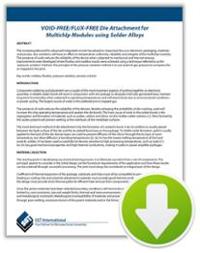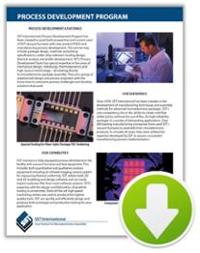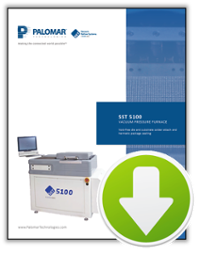SST Vacuum Reflow Systems designs and builds systems and processes that achieve low to void-free seals for die attach component parts. However, the choice of materials is critical in achieving the most positive results by allowing good wettability, thus creating a good solder joint. Void-free solder joints mean improved thermal performance and high reliability (e.g. mechanical strength) of the device package.
Choice of Materials
SST Vacuum Reflow Systems works with many different alloys in developing profiles and recipes for die attach processes. Such alloys include:
- 80Au20Sn (280°C melting point)
- 60In40Pb (174-183°C melting point)
- 97In3Ag (143°C melting point)
- 95Sn5Ag (240-221°C melting point)
- 80In15Pb5Ag (149-154°C melting point)
The majority of our customers use 80Au20Sn because no acid etch is required, and the final package has high thermal conductivity and high tensile strength. Some use less expensive, low temperature alloys such as those listed above, but these require an oxide removal procedure adding to complexity and expense. Such low temperature alloys are used for devices that may be damaged in high temperature applications.
Typically, SST recommends alloys to be 1 mil thick for die attach applications, and there are other factors to consider when choosing the correct preform material:
- What is the maximum temperature that component parts can be exposed to without causing any damage?
- Different alloys require higher than melting temperatures for good flow and wetting. Can the device withstand harsh temperatures? (i.e. above melting point of solder, 50°C-75°C)
- What are the die and substrate metallizations?
- Do the customers have the correct metallizations for the specific alloy of choice?
- Does the solder flow well?
[Please refer to the SST Plating Requirements paper for more detailed information.]
When using gold/tin, the Au purity and Au quality of the component parts is very important in achieving void-free joints. SST recommends that the highest quality of Au be used. Further, we recommend that no brighteners are added to Au. This is because solder may not wet to Au that has brighteners in it. In addition, the amount of alloy applied is critical to maximizing performance. For example, for Ni/Au, the Au plating thickness SST recommends is a minimum of 50 microinches. Plating thicknesses should not exceed 150 microinches. An excerpt from SST’s Plating Requirements paper is below for AuSn, SnPb, PbIn, SnIn, PbSnAg, PbInAg, or SnAg:
- “Underplate with solderable nickel sulfamate per QQ-N-290, 50-150 microinches thick.
- Gold plate per Mil-G-45204, Type III, Grade a, 50-150 microinches thick (Class 1).”
Material Preparation and Storage
Pre-cleaning options for preforms are available which include: 1) acid-etch, 2) formic acid, 3) forming gas, and 4) plasma etch. Customers are urged to have no oxidation of the preform. Oxide layers prevent good wetting and increase void levels which will degrade the seal and decrease the reliability of the component parts. In order to prevent oxidation of preforms, customers should store preforms in an N2 storage box.
Conclusion
SST systems consistently achieve <5% voids for die-attach applications. We use vacuum and pressure to achieve this result, but proper material choices are a necessity to reduce void levels. Preforms must be chosen carefully. Once chosen, they must be properly handled and stored prior and after reflow processes to achieve <5% to void-free die attach on all component parts.
Download these resources for more information:
| Void-Free Die Soldering paper |
Process Development Data Sheet |
Model 5100 Data Sheet |
 |
 |
 |
---
Adrienne D. Williams. Ph.D.
Process Engineer
SST Vacuum Reflow Systems